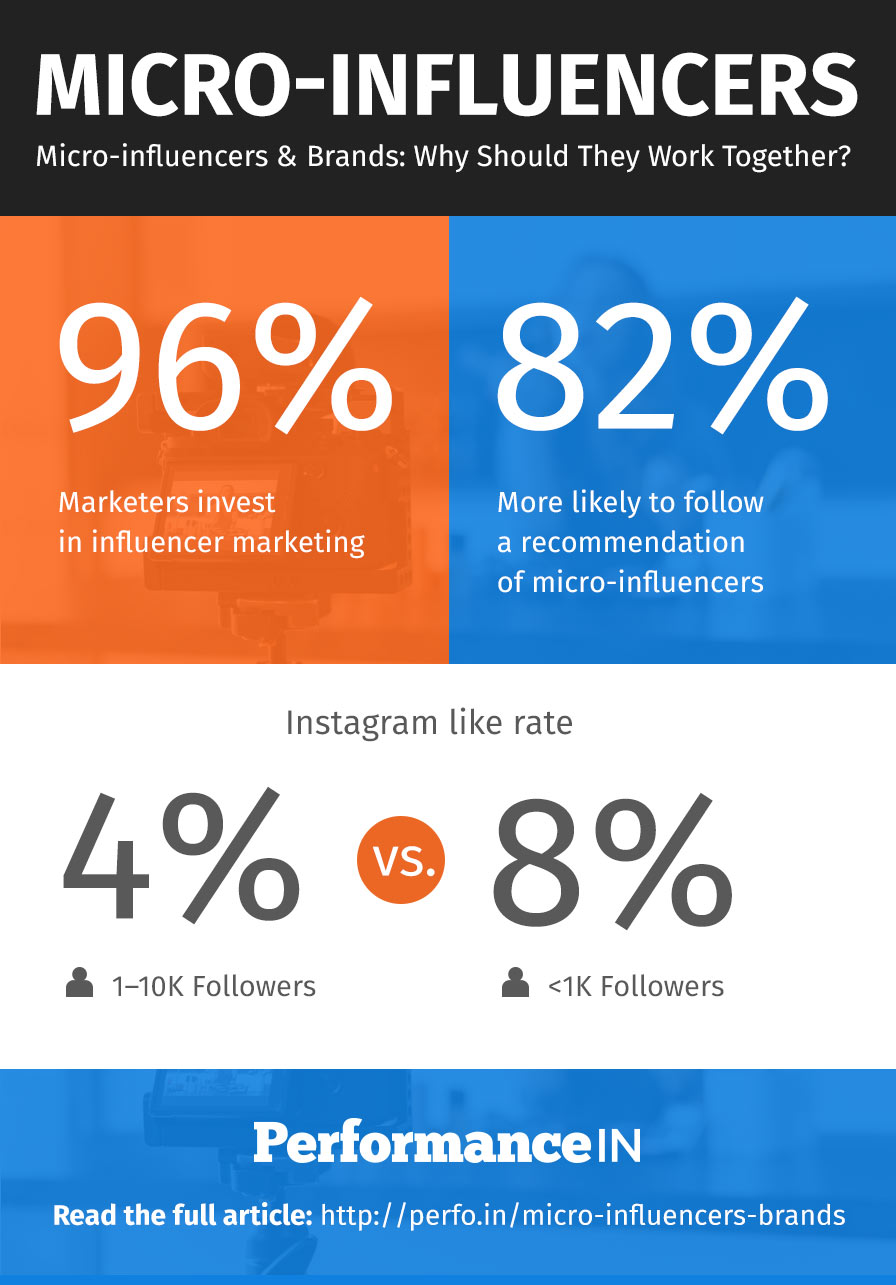From lifestyle bloggers to social celebrity stars; there’s no question of the impact influencer marketing has had in the digital advertising space.
Marketers are now seeing influencer marketing as a respectable avenue for advertising and marketing performance, with 96% investing in the channel and a further 9% set to spend over £100,000 on influencers in the next 12 months.
With this in mind and consumers trusting influencers, it is imperative for brands to consider working with them to promote products and target their audiences. In addition to this, the so called ‘micro-influencer’ is driving buying behaviour to smaller, more targeted audiences, through reliable and credible channels which offer knowledgeable, passionate and authentic material; establishing themselves as a trusted source when it comes to product recommendations and purchases.
Micro-influencers vs macro-influencers
In the past, influencer marketing was the reserve of large brands with big budgets who sought to tap into celebrity profiles with astronomical followings often at price points seemingly pulled out of the sky with often little regard paid to measurement of return. The positive, initially, is that the brand would be exposed to larger audiences. However, this comes at the cost of poorer quality reach and questions over the real value of engagement.
However, the advent of the micro-influencer has changed things; building their followers online through niche communities – such as fashion, beauty, food or photography – and with a social following between 1,000 and 100,000, the draw of this group of influencers is their comparatively small, niche audience.
For advertisers, this audience – drawn to the influencer by their specialist content and authenticity – represents a much more targeted group of consumers, whose interests and characteristics can be inferred and targeted with relevant products and services.
It’s been found that 82% of people are more likely to follow a recommendation of one of these micro-influencers when it comes to choosing products or services. According to social media influencer agency, HelloSociety, they also deliver a 60% higher engagement rate than their larger social counterparts, and when it comes to influencing purchases, micro-influencers have up to 22 times more conversations each week regarding recommendations on what consumers should purchase.
According to influencer marketing platform Markerly, micro-influencers with between 1,000 to 10,000 followers on instagram have a like rate of 4%, whereas those with fewer than 1,000 followers on Instagram have a like rate of 8%. This is double the rate, and evidence that trust is a lot more prevalent, owed to micro-influencers genuine and organic interests in the products they post about.
Building relationships
“Influencers constantly listen to their audiences and deep dive into their analytics to understand what resonates best,” said Matt Donegan, CEO of influencer marketing platform Social Circle.
“The more engaged your audience is, the more likely they are to listen to your messaging. Use micro-influencers’ small audience to utilise their incredibly engaged audience and target your message to those to really want to hear it.”
Despite the benefits, however, working with micro-influencers requires a delicate approach, and will only work out if marketers pair up with the right influencers which match their brand and strategic goals. Both parties, if keen to work together, need to look much deeper into the mix. Is there a connection between the brand and influencer based on relationships and shared interests, and if so is the campaign over time measurable?
One company that specialises in building these relationships is micro-influencer platform TRIBE, which brings together successful influencers with followings of around 3,000 – or “everyday people” – and brands, allowing the influencers to get paid to promote products they already use and love.
According to founder, Jules Lund, using cost-effective content creators is “the only way brands can keep up with the non-stop demand for fresh, relevant, local content needed to power personalised cross-channel marketing campaigns.”
TRIBE’s success in this arena is undeniable. Most recently, the platform partnered with Unilever and its market-leading margarine brand Stork, asking influencers for images of recipes they had made using the product, leading to around 436,000 followers seeing the images and generating 11,990 likes and comments and cost per engagement of 16p.
“We know influencer-generated-content has a four times higher CTR [Click Through Rate] when used to power social campaigns, but having your customers create your content can generate results in other, more traditional marketing channels as well.” said Lund.
How do influencers benefit?
While the benefits to brands who get it right is highly engaged audience, and potential sales, the burden really falls on the influencers who are risking their hard-earned following’s trust and loyalty if they don’t hit the mark.
London-based blogger Cecile runs The Frenchie Mummy – where she shares her opinions and thoughts on baby, lifestyle and food products – and has worked with a number of brands, including Halfords, Angel’s Face and Book Trust.
“It’s important for brands to look at influencers’ platform very carefully and not impose a tone on them,” said Cecile; “To be engaging and successful, the content must represent the influencer and its own style. There’s no need to see the same kind of content on many different platforms – it’s boring. We all have a specific angle.”
According to micro-influencer and blogger Kumba Dauda who runs fashion beauty lifestyle blog Kumbear XO, working with micro-influencers is a “much better long-term strategy”; “Micro-influencers are beginning to seem more trustworthy and appealing to the public as they can offer much more raw, personal content that can resonate with people.”
Research is vital
Brands and influencers can prosper if the products and content match both their strategy and audience. However, this sometimes might not go to plan and it is crucial for brands to conduct due diligence into what the influencers really do, their tone and character, and who their followers are.
Food and lifestyle instagram influencer, Charlotte Rollin, recently criticised diet company The Choco Diet for its repeated approach for her to become a brand ambassador publicly complaining that a company which claims that you can lose as many pounds as possible in one month was simply inappropriate. This was especially poignant given that Rollin had earned her loyal following thanks to her candid posts which recount her journey regarding mental health and struggle with anorexia.
For marketers looking to enter into the new world of micro-influencers, the lesson is to do your research with sensitivity and detail before approaching with a pitch, as “one wrong move” could be damaging to a brand’s reputation. This is, after all, individual people you’re dealing with, often with much strong and personal relationships with their following.
“Brands should be providing influencers with a clear and precise brief in order to make this happen. I always like when brands send me a mood board so I can understand exactly what type of content they are looking for,” commented Dauda.
Can social campaigns be measured?
When it comes to proving the value of your work with micro-influencers, Lund believes there will be a huge investment in this area going into 2018.
“The upcoming year will see brands combining various ‘tiers’ of influencers to achieve their marketing goals, combining mixes of different levels of reach and frequency, as well as varying storytelling abilities – broad communication vs niche,” said Lund.
“We’re finding brands are looking to influencer and social marketing to build an experience and emotional connection between their customers.”
According to Donegan, the influencer industry is “craving for” advances in measurement, with influencers having access to more authentic data than we can access in the public domain.
“There are the typical tracking methods such as trackable links and pixels, and these can be implemented in influencer campaigns more than you may think. But the crux of an influencer’s value is based on their trust and heritage,” said Donegan.
“The combination of these two mean that you can go on what we like to call an ‘Engagement Excursion’ – which allows you to measure the spread of a campaign beyond its designated social homes.”
It’s evident there are huge benefits to be had for brands working together with micro-influencers. However, marketers must be vigilant in doing research before approaching the influencer of choice, knowing their interest, followers and demographics.
If there is compatibility, brands can then create targeted social campaigns assured to reach their intended audience, through organic, trustworthy and authentic content. In return, this results in higher engagement and fully-accountable campaign spend.


